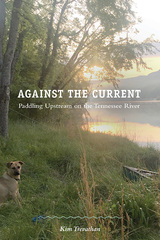
In August 1998 Kim Trevathan summoned his beloved 45-pound German shepherd mix, Jasper, and paddled a canoe down the Tennessee River, an adventure chronicled in Paddling the Tennessee River: A Voyage on Easy Water. Twenty years later, in Against the Current: Paddling Upstream on the Tennessee River, he invites readers on a voyage of light-hearted rumination about time, memory, and change as he paddles the same river in the same boat—but this time going upstream, starting out in early spring instead of late summer. In sparkling prose, Trevathan describes the life of the river before and after the dams, the sometimes daunting condition of its environment, its banks’ host of evolving communities—and also the joys and follies of having a new puppy, 65-pound Maggie, for a shipmate.
Trevathan discusses the Tennessee River’s varied contributions to the cultures that hug its waterway (Kentuckians refer to it as a lake, but Tennesseans call it a river), and the writer’s intimate style proves a perfect lens for the passageway from Kentucky to Tennessee to Alabama and back to Tennessee. In choice observations and chance encounters along the route, Trevathan uncovers meaningful differences among the Tennessee Valley’s people—and not a few differences in himself, now an older, wiser adventurer.
Whether he is struggling to calm his land-loving companion, confronting his body’s newfound aches and pains, craving a hard-to-find cheeseburger, or scouting for a safe place to camp for the night, Trevathan perseveres in his quest to reacquaint himself with the river and to discover new things about it. And, owing to his masterful sense of detail, cadence, and narrative craft, Trevathan keeps the reader at the heart of the journey. The Tennessee River is a remarkable landmark, and this text exhibits its past and present qualities with a perspective only Trevathan can provide.
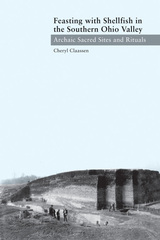
In this provocative work, Cheryl Claassen challenges long-standing notions n this provocative work, Cheryl Claassen challenges long-standing notions Iabout hunter-gatherer life in the southern Ohio Valley as it unfolded some Iabout hunter-gatherer life in the southern Ohio Valley as it unfolded some I8,000 to 3,500 years ago. Focusing on freshwater shell mounds scattered 8,000 to 3,500 years ago. Focusing on freshwater shell mounds scattered along the Tennessee, Ohio, Green, and Harpeth rivers, Claassen draws on the latest archaeological research to offer penetrating new insights into the sacred world of Archaic peoples. Some of the most striking ideas are that there were no villages in the southern Ohio Valley during the Archaic period, that all of the trading and killing were for ritual purposes, and that body positioning in graves reflects cause of death primarily.
Mid-twentieth-century assessments of the shell mounds saw them as the products of culturally simple societies that cared little about their dead and were concerned only with food. More recent interpretations, while attributing greater complexity to these peoples, have viewed the sites as mere villages and stressed such factors as population growth and climate change in analyzing the way these societies and their practices evolved. Claassen, however, makes a persuasive case that the sites were actually the settings for sacred rituals of burial and
renewal and that their large shell accumulations are evidence of feasts associated with those ceremonies. She argues that the physical evidence—including the location of the sites, the largely undisturbed nature of the deposits, the high incidence of dog burials, the number of tools per body found at the sites, and the indications of human sacrifice and violent death—not only supports this view but reveals how ritual practices developed over time. The seemingly sudden demise of shellfish consumption, Claassen contends, was not due to overharvesting and environmental change; it ended, rather, because the sacred rituals changed.
Feasting with Shellfish in the Southern Ohio Valley is a work bound to stir controversy and debate among scholars of the Archaic period. Just as surely, it will encourage a new appreciation for the spiritual life of ancient peoples—how they thought about the cosmos and the mysterious forces that surrounded them.


Accompanied by the author's striking line drawings, each chapter in Natural Histories showcases a particular animal or plant and each narrative begins or ends in, or passes through the Tennessee Valley. Along the way, historical episodes both familiar and obscure-the de Soto explorations, the saga of the Lost State of Franklin, the devastation of the Trail of Tears, and the planting of a “Moon Tree” at Sycamore Shoals in Elizabethton-are brought vividly to life. Bales also highlights the work of present-day environmentalists and scientists such as the dedicated staffers of the Tennessee-based American Eagle Foundation, whose efforts have helped save the endangered raptors and reintroduce them to the wild.
Arranged according to the seasonal cycles of the valley, Bales's essays reveal the balance that nature has achieved over millions of years, contrasting it with the messier business of human endeavor, especially the desire to turn nature into a commodity, something to be subdued and harvested. Filled with delightful twists and turns, Natural Histories is also a book brimming with important lessons for us all.
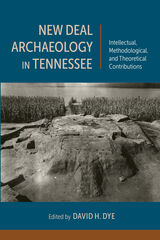
New Deal Archaeology in Tennessee tells the engrossing story of Southeastern archaeology in the 1930s. The Tennessee Valley Authority Act of May 1933 initiated an ambitious program of flood control and power generation by way of a chain of hydroelectric dams on the Tennessee River. The construction of these dams flooded hundreds of thousands of square miles of river bottoms, campsites, villages, and towns that had been homes to Native Americans for centuries. This triggered an urgent need to undertake extensive archaeological fieldwork throughout the region. Those studies continue to influence contemporary archaeology.
The state of Tennessee and the Tennessee Valley were especially well suited research targets thanks to their mild climate and long field seasons. A third benefit in the 1930s was the abundance of labor supplied by Tennesseans unemployed during the Great Depression. Within months of the passage of the Tennessee Valley Authority Act, teams of archaeologists fanned out across the state and region under the farsighted direction of Smithsonian Institution curators Neil M. Judd, Frank H. H. Roberts, and Frank M. Setzler. The early months of 1934 would become the busiest period of archaeological fieldwork in US history.
The twelve insightful essays in New Deal Archaeology in Tennessee document and explore this unique peak in archaeological study. Chapters highlight then-new techniques such as mound “peeling” and stratigraphic excavation adapted from the University of Chicago; the four specific New Deal sites of Watts Bar Reservoir, Mound Bottom, Pack, and Chickamauga Basin; bioarchaeology in the New Deal; and the enduring impact of the New Deal on contemporary fieldwork.
The challenges of the 1930s in recruiting skilled labor, training unskilled ancillary labor, developing and improvising new field methods, and many aspects of archaeological policies, procedures, and best-practices laid much of the foundation of contemporary archaeological practice. New Deal Archaeology in Tennessee offers an invaluable record of that pivotal time for professional, student, and amateur archaeologists.
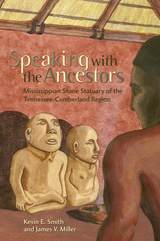
When European explorers began their initial forays into southeastern North America in the 16th and 17th centuries they encountered what they called temples and shrines of native peoples, often decorated with idols in human form made of wood, pottery, or stone. The idols were fascinating to write about, but having no value to explorers searching for gold or land, there are no records of these idols being transported to the Old World, and mention of them seems to cease about the 1700s. However, with the settling of the fledgling United States in the 1800s, farming colonists began to unearth stone images in human form from land formerly inhabited by the native peoples. With little access to the records of the 16th and 17th centuries, debate and speculation abounded by the public and scholars alike concerning their origin and meaning.
During the last twenty years the authors have researched over 88 possible examples of southeastern Mississippian stone statuary, dating as far back as 1,000 years ago, and discovered along the river valleys of the interior Southeast. Independently and in conjunction, they have measured, analyzed, photographed, and traced the known history of the 42 that appear in this volume. Compiling the data from both early documents and public and private collections, the authors remind us that the statuary should not be viewed in isolation, but rather as regional expressions of a much broader body of art, ritual, and belief.
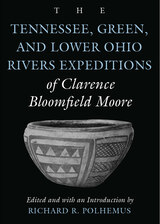
This richly illustrated book is the eighth of nine Classics in Southeastern Archaeology volumes based on Moore's investigations along the waterways of eastern North America.
This oversized reprint volume presents original materials from Moore's northernmost expeditions conducted in the early 1900s as he surveyed areas of potential archaeological interest in the southeastern United States. Some of the sites he found were later targeted for major excavations during the days of the WPA/CCC. Many National Register Historic Sites are today located along the rivers he explored in this work. In many cases, however, Moore's report documents sites since destroyed by river action or by lake impoundments behind hydroelectric dams or by looters.
As with all of Moore's other investigations, his thorough documentation and collaboration with other scholars advanced understanding of aboriginal peoples and fueled debate among the experts. For instance, more than 296 burials were recovered from Indian Knoll on the Green River in Kentucky. Some graves included ceremonially "killed" artifacts, dogs buried with both adults and children, and exotic materials leading to speculations concerning origins, usage, and trade networks. Stone box graves were widespread and somewhat exclusive to this area, giving rise to early assumptions regarding kinship between scattered modern Indian tribes.
Richard Polhemus has compiled a comprehensive inventory of Moore's work in Tennessee, Alabama, Mississippi, and Kentucky and written a concise introduction to place the work in context. In so doing, he has made available to contemporary scholars of history, archaeology, and anthropology a trove of resource material on one of the most archaeologically rich and artifact-diverse regions in the nation.

READERS
Browse our collection.
PUBLISHERS
See BiblioVault's publisher services.
STUDENT SERVICES
Files for college accessibility offices.
UChicago Accessibility Resources
home | accessibility | search | about | contact us
BiblioVault ® 2001 - 2024
The University of Chicago Press









